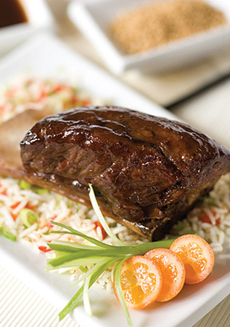

Photo courtesy MackenzieLtd.com.
July 2010
|
 |
Recipe: Beef Bourguignon With Short Ribs
Cook Short Ribs With A Pressure Cooker To Save Time
Beef Bourguignon is a traditional French recipe for stew prepared with beef braised in red wine. The recipe, also known as boeuf bourguignon or boeuf à la bourguignonne, is generally flavored with garlic and onions, and the red wine typically used is red Burgundy. But you don’t have to cut the meat into stew chunks: The technique works well with short ribs.
Beef Bourguignon With Short Ribs
We made our recipe in the Kuhn Rikon Ecomatic Pressure Cooker and used short ribs as the beef. Yields 4 servings.
Ingredients
- 4 to 5 short ribs, cut thick (not thin-cut Korean-style short ribs)
- 1 large onion, medium dice
- 1 carrot, medium dice
- 1 stalk celery, medium dice
- 4 cloves garlic
- 2 tablespoons tomato paste
- 3 plum tomatoes, chopped
- ¼ cup brandy
- 1 cup red wine
- 3 to 4 tablespoons flour
- 8 springs thyme
- 1 bay leaf
- 6 to 8 parsley stems (optional)
- Up to 4 tablespoons cooking oil
- Salt and pepper
- About 4 to 6 cups (more if needed) chicken stock
NOTE: Chicken Stock Vs. Beef Stock
You can use beef stock if you have it. We prefer to use chicken stock in most dishes since it creates a lighter sauce, and its lighter flavor enables herbs and other seasonings to show through better. Beef stock is a classic in French onion soup and deeply-flavored meat sauces; it is much more flavor-intense than chicken stock.
Preparation
-
Season meat with salt and pepper while pre-heating pressure cooker over a medium-high flame. When hot, add just enough oil to coat bottom of pot (about two tablespoons) and brown meat on all sides, being careful that there is enough space between each rib for moisture to escape. This way, the short ribs will brown, and not steam. Work in batches, if necessary.
-
Remove meat and set aside. Pour out excess fat and check to see that nothing has burned on the bottom of the pot. If so, clean the pot and add fresh oil.
-
Toss in onion, carrot, celery and garlic, and season with salt and pepper. Sweat until tender.
-
Stir in tomato paste and cook for about 1 minute to remove raw tomato paste flavor, stirring once or twice to avoid burning.
-
Sprinkle flour over vegetables, stir and cook for about 1 minute to remove raw flour taste.
-
Add in chopped tomatoes and season mixture with salt and pepper.
-
Pour in brandy. (At this point, flambé* is optional, but should be done very carefully. If choosing to flambé, turn off burner, add brandy and then light with stick lighter. Then, turn heat back on and wait until flambé has died out before proceeding.) Reduce the brandy by ½, about 3 to 4 minutes.
- Pour in red wine and reduce mixture by another ½, about 7 to 10 minutes.
-
Fold in the beef and any juices that have accumulated along with thyme, bay leaf and parsley stems.
-
Pour in enough chicken stock to cover beef, being careful not to fill past the 2/3 mark on the inside of the pressure cooker.
-
Lock lid on pressure cooker and raise heat to high. Wait until you can see the second red ring on the valve on the top of the pressure cooker before lowering the heat to maintain pressure at that second ring. (If pressure exceeds the second red ring, de-pressurize the appliance by pushing down the valve, or pressure release knob until you can just see the red ring, and lower heat further.)
-
Cook 30 to 40 minutes until beef is tender. If you open the pressure cooker and discover it is not yet tender, place lid back on, re-pressurize the appliance and cook 5 to 10 minutes more.
-
Turn off heat and let beef rest in pot and in liquid for 15 minutes before removing the lid.
-
Remove beef and vegetables; retaining the liquid in the pot. Reduce liquid until it can coat the back of a spoon and adjust seasoning with salt and pepper.
*Flambé (pronounced flahm-BAY) is a French technique in which a spirit that has a proof of 80 or above (40% liquor) is ignited. Some think this is merely for dramatic presentation. However, others believe that lighting the spirit causes a more complex flavor reaction. Since alcohol boils at 172ºF, water boils at 212ºF and sugar caramelizes at 320ºF, all these actions occur simultaneously in a flambé, which changes the chemistry of food. But since taste is subjective, many people cannot discern the flavor of flambéed food.
Recipe

|




